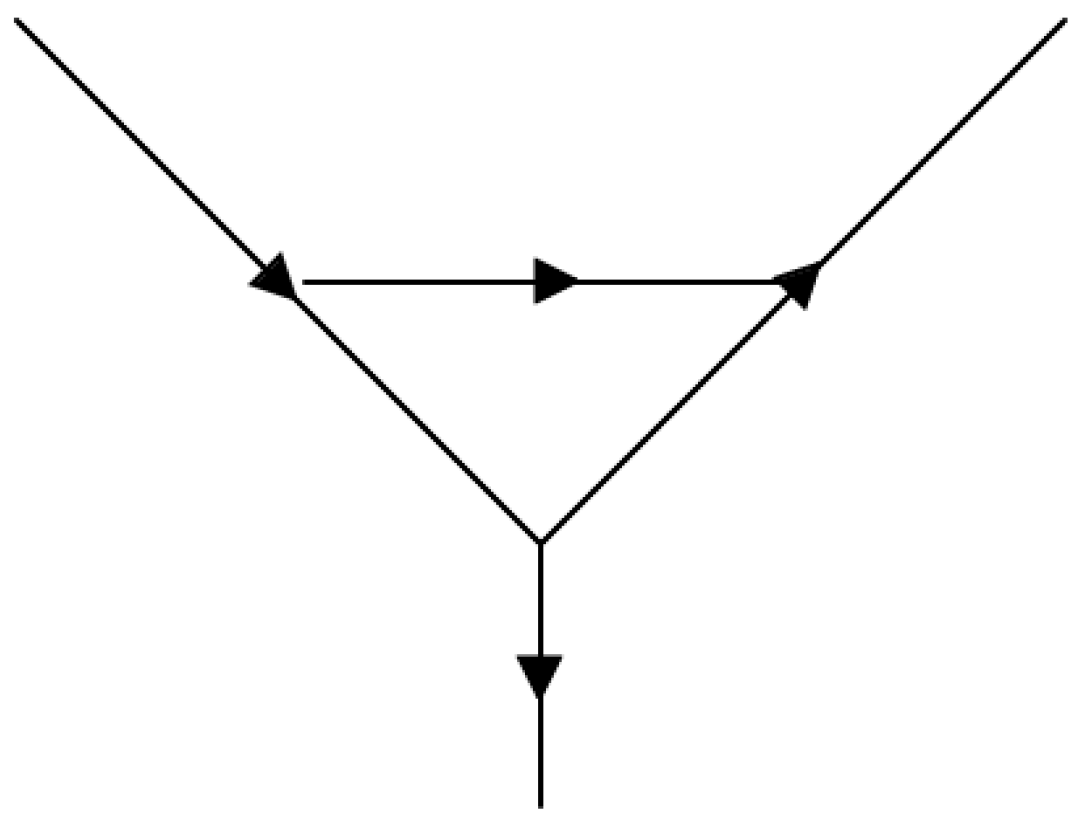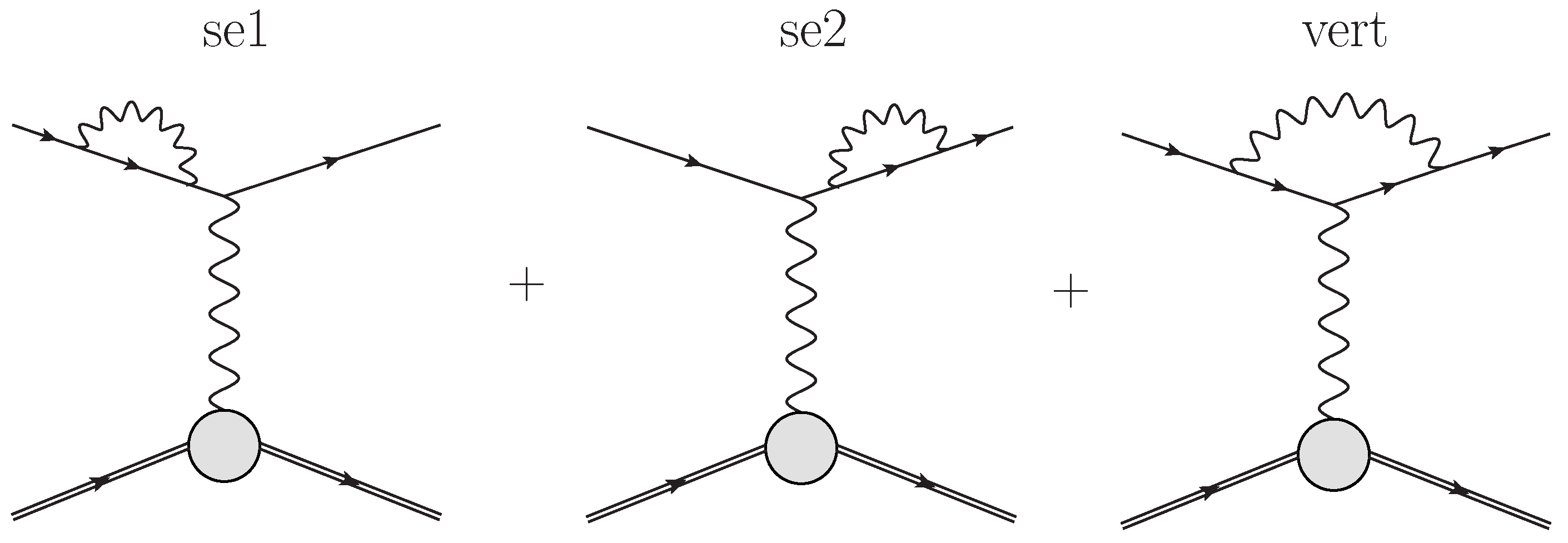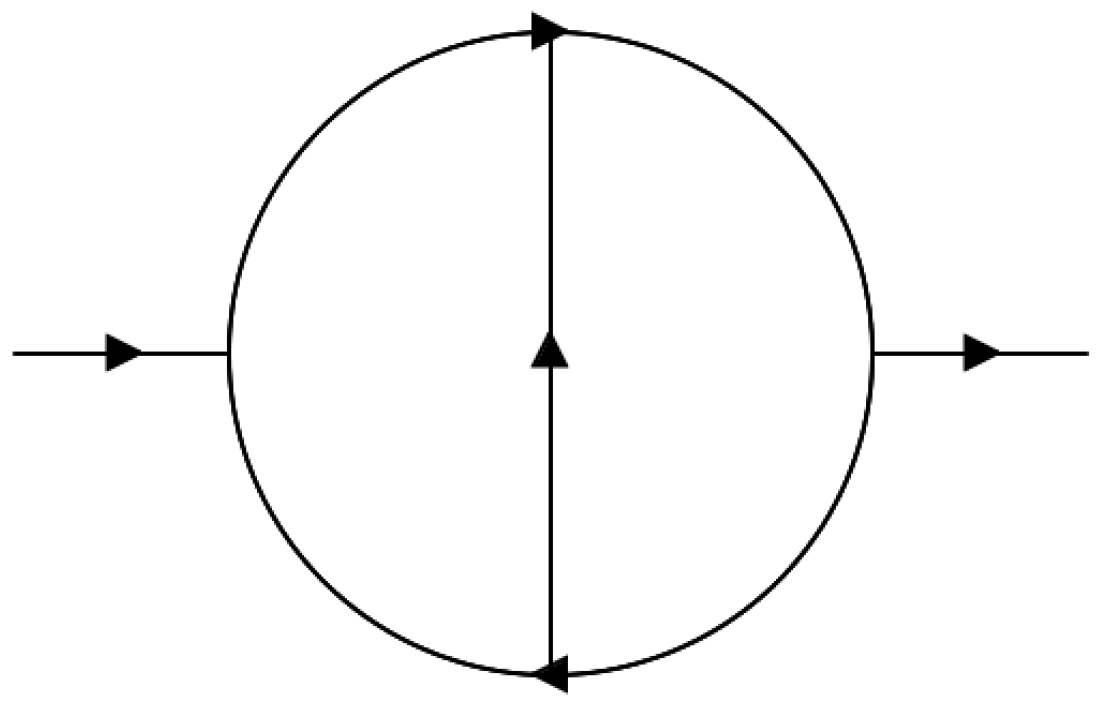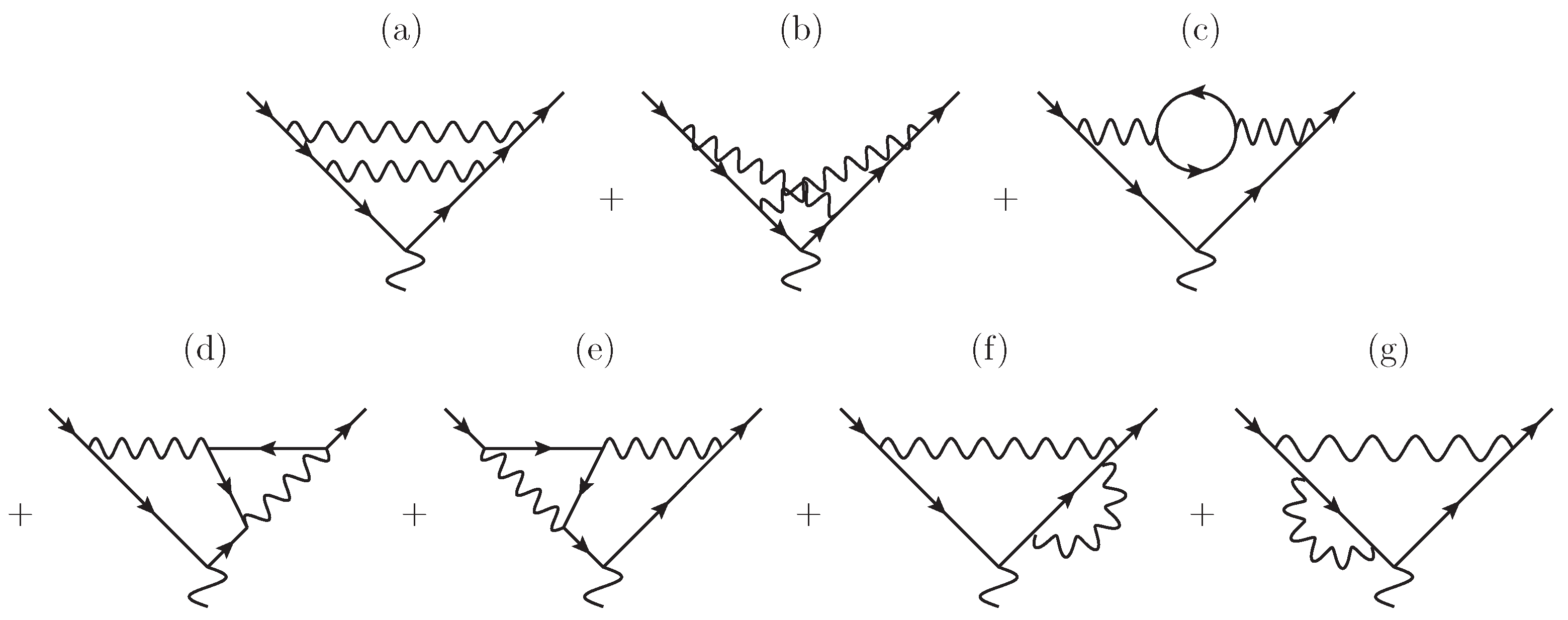Vanishing Cycles and Analysis of Singularities of Feynman Diagrams
Abstract
1. Introduction
- (Section 2) We start the analysis in the momentum q-space.
- (Section 3) Then, we continue with a discussion of vanishing cycles since they are a mechanism that leads to the formation of singularities. One can observe the usefulness of the Mayer–Vietoris spectral sequence for a classification of possible types of singularities (for a general introduction to the use of Mayer–Vietoris sequences as applied to the topology of projective complete intersections, we refer to Refs. [69,70]). We give a complete classification of the localization of the vanishing cycles with the case of generic polynomials. Non-local vanishing cycles are outlined as well.
- (Section 4) Herein, we introduce the so-called “pinch map”: a map from the singular locus to the space of the (virtual) loop momenta of particles that gives the location of a point to which the vanishing cycle becomes contractible. The pinch map simplifies calculations for asymptotic analysis and must have some meaning for generic GZK functions as well. Two cases of pinching are presented: with general polynomials and with Feynman loop integrals.
- (Section 5) We consider specific examples of vertex loop diagrams, which may potentially be applied to the lepton–proton () scattering process (the scattering of spin-1/2 particles).
- (Section 6) The so-called “-series” method is outlined, through which it may be possible to later calculate the scattering amplitudes and cross-sections with lowest- and higher-order radiative corrections of QED (quantum electrodynamics), by computing the contributions from one-loop and two-loop Feynman diagrams, as well as from other next-to-leading and higher-order diagrams.
- (Section 7) At the end, we discuss our results and give a direction for future developments.
2. Preliminaries
3. Homology Vanishing Cycles
3.1. Vanishing Cycles and Generic Polynomials
3.2. Non-Local Vanishing Cycles
- (i)
- The number of derivatives, , that vanish along the stratum for some set of multi-indices, ;
- (ii)
- The geometric locus, where such vanishing happens.
4. Introduction of Pinch Map
4.1. Pinch Map I: General Polynomials
4.2. Pinch Map II: Feynman Loop Integrals
5. Examples with Feynman Vertex Loop Diagrams
5.1. Vertex Diagram at One Loop: General Case
5.2. Propagator at Two Loops: General Case
5.3. Vertex Diagram at Two Loops
5.3.1. General Case
5.3.2. Five-Pinch Point for Arbitrary Mass Vertex
5.3.3. QED Case
5.3.4. Five-Pinch Point for QED Vertex
6. Outlining the Method of Series for Performing Potentially New Types of Lepton–Proton Cross-Section Calculations in the Future
7. Discussion
Author Contributions
Funding
Data Availability Statement
Conflicts of Interest
References
- Fotiadi, D.; Froissart, M.; Lascoux, J.; Pham, F. Applications of an isotopy theorem. Topology 1965, 4, 159–191. [Google Scholar] [CrossRef]
- Pham, F. Singularities of Integrals: Homology, Hyperfunctions and Microlocal Analysis; Springer Science & Business Media: Berlin/Heidelberg, Germany, 2011. [Google Scholar]
- Leray, J. Le calcul différentiel et intégral sur une variété analytique complexe.(Problème de Cauchy. III.). Bull. Soc. Math. Fr. 1959, 87, 81–180. [Google Scholar] [CrossRef]
- Kashiwara, M. B-functions and holonomic systems. Invent. Math. 1976, 38, 33–53. [Google Scholar] [CrossRef]
- Hwa, R.C.; Teplitz, V.L. Homology and Feynman integrals. Nucl. Phys. A 1967, 98, 627. [Google Scholar]
- Kontsevich, M. Intersection theory on the moduli space of curves and the matrix Airy function. Commun. Math. Phys. 1992, 147, 1–23. [Google Scholar] [CrossRef]
- Eden, R.J.; Landshoff, P.V.; Olive, D.I.; Polkinghorne, J.C. The Analytic S-Matrix; Cambridge University Press: Cambridge, UK, 2002. [Google Scholar]
- Griffiths, P.A. Periods of integrals on algebraic manifolds, I. (construction and properties of the modular varieties). Am. J. Math. 1968, 90, 568–626. [Google Scholar] [CrossRef]
- Manin, Y.I. Algebraic curves over fields with differentiation. Izv. Ross. Akad. Nauk. Seriya Mat. 1958, 22, 737–756. [Google Scholar]
- Gelfand, I.; Kapranov, M.; Zelevinskii, A. Discriminants, Resultants, and Multidimensional Determinants; Springer: Berlin/Heidelberg, Germany, 1994. [Google Scholar]
- Ananthanarayan, B.; Banik, S.; Bera, S.; Datta, S. FeynGKZ: A Mathematica package for solving Feynman integrals using GKZ hypergeometric systems. Comput. Phys. Commun. 2023, 287, 108699. [Google Scholar] [CrossRef]
- Fevola, C.; Mizera, S.; Telen, S. Principal Landau determinants. Comput. Phys. Commun. 2024, 303, 109278. [Google Scholar] [CrossRef]
- de la Cruz, L. Feynman integrals as A-hypergeometric functions. J. High Energy Phys. 2019, 2019, 123. [Google Scholar] [CrossRef]
- Feng, T.F.; Chang, C.H.; Chen, J.B.; Zhang, H.B. GKZ-hypergeometric systems for Feynman integrals. Nucl. Phys. B 2020, 953, 114952. [Google Scholar] [CrossRef]
- Mühlbauer, M. Cutkosky’s theorem for massive one-loop Feynman integrals: Part 1. Lett. Math. Phys. 2022, 112, 118. [Google Scholar] [CrossRef]
- Pathak, T.; Sreekantan, R. Singularities of Feynman Integrals. Eur. Phys. J. Spec. Top. 2024, 233, 2037–2055. [Google Scholar] [CrossRef]
- Yelleshpur Srikant, A. Spherical Contours, IR Divergences and the geometry of Feynman parameter integrands at one loop. J. High Energy Phys. 2020, 2020, 236. [Google Scholar] [CrossRef]
- Dlapa, C.; Henn, J.; Yan, K. Deriving canonical differential equations for Feynman integrals from a single uniform weight integral. J. High Energy Phys. 2020, 2020, 25. [Google Scholar] [CrossRef]
- Smirnov, A.; Smirnov, V. How to choose master integrals. Nucl. Phys. B 2020, 960, 115213. [Google Scholar] [CrossRef]
- Hannesdottir, H.S.; McLeod, A.J.; Schwartz, M.D.; Vergu, C. Implications of the Landau equations for iterated integrals. Phys. Rev. D 2022, 105, L061701. [Google Scholar] [CrossRef]
- Bourjaily, J.L.; Hannesdottir, H.; McLeod, A.J.; Schwartz, M.D.; Vergu, C. Sequential Discontinuities of Feynman Integrals and the Monodromy Group. J. High Energy Phys. 2021, 2021, 205. [Google Scholar] [CrossRef]
- Aoyama, T.; Hayakawa, M.; Kinoshita, T.; Nio, M. Tenth-order QED contribution to the electron g-2 and an improved value of the fine structure constant. Phys. Rev. Lett. 2012, 109, 111807. [Google Scholar] [CrossRef]
- Aoyama, T.; Asmussen, N.; Benayoun, M.; Bijnens, J.; Blum, T.; Bruno, M.; Caprini, I.; Calame, C.C.; Cè, M.; Colangelo, G.; et al. The anomalous magnetic moment of the muon in the Standard Model. Phys. Rep. 2020, 887, 1–166. [Google Scholar] [CrossRef]
- Jegerlehner, F. The Anomalous Magnetic Moment of the Muon; Springer: Berlin/Heidelberg, Germany, 2008. [Google Scholar]
- Keshavarzi, A.; Nomura, D.; Teubner, T. Muon g- 2 and α (M Z 2): A new data-based analysis. Phys. Rev. D 2018, 97, 114025. [Google Scholar] [CrossRef]
- Campbell, M.J.; Ellis, R.K.; Williams, C. Associated production of a Higgs boson at NNLO. J. High Energy Phys. 2016, 2016, 179. [Google Scholar] [CrossRef]
- Hessenberger, S.; Hollik, W. Two-loop improved predictions for MW and sin2 θeff in Two-Higgs-Doublet models. Eur. Phys. J. C 2022, 82, 970. [Google Scholar] [CrossRef]
- Ahmed, T.; Ravindran, V.; Sankar, A.; Tiwari, S. Two-loop amplitudes for di-Higgs and di-pseudo-Higgs productions through quark annihilation in QCD. J. High Energy Phys. 2022, 2022, 189. [Google Scholar] [CrossRef]
- Maximon, L.C.; Tjon, J.A. Radiative corrections to electron proton scattering. Phys. Rev. C 2000, 62, 054320. [Google Scholar] [CrossRef]
- Gramolin, A.V.; Fadin, V.S.; Feldman, A.L.; Gerasimov, R.E.; Nikolenko, D.M.; Rachek, I.A.; Toporkov, D.K. A new event generator for the elastic scattering of charged leptons on protons. J. Phys. G 2014, 41, 115001. [Google Scholar] [CrossRef]
- Akushevich, I.; Gao, H.; Ilyichev, A.; Meziane, M. Radiative corrections beyond the ultra relativistic limit in unpolarized ep elastic and Møller scatterings for the PRad Experiment at Jefferson Laboratory. Eur. Phys. J. A 2015, 51, 1. [Google Scholar] [CrossRef]
- Bucoveanu, R.D.; Spiesberger, H. Second-Order Leptonic Radiative Corrections for Lepton-Proton Scattering. Eur. Phys. J. A 2019, 55, 57. [Google Scholar] [CrossRef]
- Fadin, V.S.; Gerasimov, R.E. On the cancellation of radiative corrections to the cross section of electron-proton scattering. Phys. Lett. B 2019, 795, 172–176. [Google Scholar] [CrossRef]
- Banerjee, P.; Engel, T.; Signer, A.; Ulrich, Y. QED at NNLO with McMule. SciPost Phys. 2020, 9, 027. [Google Scholar] [CrossRef]
- Afanasev, A.; Ilyichev, A. Radiative corrections to the lepton current in unpolarized elastic lp-interaction for fixed Q2 and scattering angle. Eur. Phys. J. A 2021, 57, 280. [Google Scholar] [CrossRef]
- Kaiser, N.; Lin, Y.H.; Meißner, U.G. Radiative corrections to elastic muon-proton scattering at low momentum transfers. Phys. Rev. D 2022, 105, 076006. [Google Scholar] [CrossRef]
- Shumeiko, N.M.; Suarez, J.G. The QED lowest order radiative corrections to the two polarized identical fermion scattering. J. Phys. G 2000, 26, 113–127. [Google Scholar] [CrossRef]
- Kaiser, N. Radiative corrections to lepton-lepton scattering revisited. J. Phys. G 2010, 37, 115005. [Google Scholar] [CrossRef]
- Aleksejevs, A.G.; Barkanova, S.G.; Zykunov, V.A.; Kuraev, E.A. Estimating two-loop radiative effects in the MOLLER experiment. Phys. Atom. Nucl. 2013, 76, 888–900. [Google Scholar] [CrossRef]
- Aleksejevs, A.G.; Barkanova, S.G.; Bystritskiy, Y.M.; Zykunov, V.A. One-Loop Electroweak Radiative Corrections to Bhabha Scattering in the Belle II Experiment. Phys. Part. Nucl. 2020, 51, 645–650. [Google Scholar] [CrossRef]
- Zykunov, V.A. Radiative Corrections in Møller Scattering for PRad Experiment at Thomas Jefferson National Accelerator Facility (TJNAF). Phys. At. Nucl. 2021, 84, 739–749. [Google Scholar] [CrossRef]
- Banerjee, P.; Engel, T.; Schalch, N.; Signer, A.; Ulrich, Y. Møller scattering at NNLO. Phys. Rev. D 2022, 105, L031904. [Google Scholar] [CrossRef]
- Bondarenko, S.G.; Kalinovskaya, L.V.; Rumyantsev, L.A.; Yermolchyk, V.L. One-loop electroweak radiative corrections to polarized Møller scattering. arXiv 2022, arXiv:2203.10538. [Google Scholar] [CrossRef]
- Frellesvig, H.; Gasparotto, F.; Laporta, S.; Mandal, M.K.; Mastrolia, P.; Mattiazzi, L.; Mizera, S. Decomposition of Feynman Integrals by Multivariate Intersection Numbers. J. High Energy Phys. 2021, 2021, 27. [Google Scholar] [CrossRef]
- Frellesvig, H.; Gasparotto, F.; Mandal, K.M.; Mastrolia, P.; Mattiazzi, L.; Mizera, S. Vector Space of Feynman Integrals and Multivariate Intersection Numbers. Phys. Rev. Lett. 2019, 123, 201602. [Google Scholar] [CrossRef] [PubMed]
- Di Vita, S.; Laporta, S.; Mastrolia, P.; Primo, A.; Schubert, U. Master integrals for the NNLO virtual corrections to μe scattering in QED: The non-planar graphs. J. High Energy Phys. 2018, 2018, 16. [Google Scholar] [CrossRef]
- Bonisch, K.; Fischbach, F.; Klemm, A.; Nega, C.; Safari, R. Analytic structure of all loop banana integrals. J. High Energy Phys. 2021, 2021, 66. [Google Scholar] [CrossRef]
- Remiddi, E.; Tancredi, L. Schouten identities for Feynman graph amplitudes; The Master Integrals for the two-loop massive sunrise graph. Nucl. Phys. B 2014, 880, 343–377. [Google Scholar] [CrossRef]
- Chaubey, E.; Weinzierl, S. Two-loop master integrals for the mixed QCD-electroweak corrections for through a -coupling. J. High Energy Phys. 2019, 2019, 185. [Google Scholar] [CrossRef]
- Pogel, S.; Wang, X.; Weinzierl, S. The three-loop equal-mass banana integral in ε-factorised form with meromorphic modular forms. J. High Energy Phys. 2022, 2022, 62. [Google Scholar] [CrossRef]
- Weinzierl, S. Modular transformations of elliptic Feynman integrals. Nucl. Phys. B 2021, 964, 115309. [Google Scholar] [CrossRef]
- Bloch, S.; Kerr, M.; Vanhove, P. A Feynman integral via higher normal functions. Compos. Math. 2015, 151, 2329–2375. [Google Scholar] [CrossRef]
- Bloch, S.; Kerr, M.; Vanhove, P. Local mirror symmetry and the sunset Feynman integral. Adv. Theor. Math. Phys. 2017, 21, 1373–1453. [Google Scholar] [CrossRef]
- de la Cruz, L.; Vanhove, P. Algorithm for differential equations for Feynman integrals in general dimensions. Lett. Math. Phys. 2024, 114, 89. [Google Scholar] [CrossRef]
- Pögel, S.; Wang, X.; Weinzierl, S. Bananas of equal mass: Any loop, any order in the dimensional regularisation parameter. J. High Energy Phys. 2023, 2023, 117. [Google Scholar] [CrossRef]
- Klausen, R.P. Hypergeometric Series Representations of Feynman Integrals by GKZ Hypergeometric Systems. J. High Energy Phys. 2020, 2020, 121. [Google Scholar] [CrossRef]
- Pögel, S.; Wang, X.; Weinzierl, S. Taming Calabi-Yau Feynman Integrals: The Four-Loop Equal-Mass Banana Integral. Phys. Rev. Lett. 2023, 130, 101601. [Google Scholar] [CrossRef] [PubMed]
- Gelfand, I.; Zelevinskii, A.; Kapranov, M. Hypergeometric functions and toral manifolds. Funct. Anal. Its Appl. 1989, 23, 94–106. [Google Scholar] [CrossRef]
- Saito, M.; Sturmfels, B.; Takayama, N. Grobner Deformations of Hypergeometric Differential Equations; Springer Science & Business Media: Berlin/Heidelberg, Germany, 2013; Volume 6. [Google Scholar]
- Hibi, T.; Nishiyama, K.; Takayama, N. Pfaffian systems of A-hypergeometric equations I: Bases of twisted cohomology groups. Adv. Math. 2017, 306, 303–327. [Google Scholar] [CrossRef]
- Srednyak, S. Universal deformation of particle momenta space in perturbation theory. arXiv 2018, arXiv:1805.00433. [Google Scholar]
- Kashiwara, M. D-Modules and Microlocal Calculus; American Mathematical Soc.: Providence, RI, USA, 2003; Volume 217. [Google Scholar]
- Hotta, R.; Tanisaki, T. D-Modules, Perverse Sheaves, and Representation Theory; Springer Science & Business Media: Berlin/Heidelberg, Germany, 2007; Volume 236. [Google Scholar]
- Gelfand, I.M.; Kapranov, M.M.; Zelevinsky, A.V.; Gelfand, I.M.; Kapranov, M.M.; Zelevinsky, A.V. A-Discriminants; Springer: Berlin/Heidelberg, Germany, 1994. [Google Scholar]
- Arnold, V.; Gusein-Zade, S.; Varchenko, A. Singularities of Differentiable Maps: Volume II Monodromy and Asymptotic Integrals; Springer Science & Business Media: Berlin/Heidelberg, Germany, 2012; Volume 83. [Google Scholar]
- Kashiwara, M.; Schapira, P. Regular and Irregular Holonomic D-Modules; Cambridge University Press: Cambridge, UK, 2016; Volume 433. [Google Scholar]
- Deligne, P. Équations Différentielles à Points Singuliers Réguliers; Springer: Berlin/Heidelberg, Germany, 2006; Volume 163. [Google Scholar]
- Adams, L.; Bogner, C.; Weinzierl, S. The two-loop sunrise graph in two space-time dimensions with arbitrary masses in terms of elliptic dilogarithms. J. Math. Phys. 2014, 55, 102301. [Google Scholar] [CrossRef]
- Dimca, A. Singularities and Topology of Hypersurfaces; Springer Science & Business Media: Berlin/Heidelberg, Germany, 1992. [Google Scholar]
- Spanier, E.H. Algebraic Topology; Springer Science & Business Media: Berlin/Heidelberg, Germany, 1989. [Google Scholar]
- Bogner, C.; Weinzierl, S. Feynman graph polynomials. Int. J. Mod. Phys. A 2010, 25, 2585–2618. [Google Scholar] [CrossRef]
- Bott, R.; Tu, L.W. Differential Forms in Algebraic Topology; Springer: Berlin/Heidelberg, Germany, 1982; Volume 82. [Google Scholar]
- Libgober, A. Homotopy groups of the complements to singular hypersurfaces, II. Ann. Math. 1994, 139, 117–144. [Google Scholar] [CrossRef]
- Dimca, A.; Papadima, Ş.; Suciu, A.I. Topology and geometry of cohomology jump loci. Duke Math. J. 2009, 148, 405–457. [Google Scholar] [CrossRef]
- Brown, F. Mixed Tate motives over Z. Ann. Math. 2012, 175, 949–976. [Google Scholar] [CrossRef]
- Beem, C.; Ben-Zvi, D.; Bullimore, M.; Dimofte, T.; Neitzke, A. Secondary products in supersymmetric field theory. In Annales Henri Poincaré; Springer: Berlin/Heidelberg, Germany, 2020; pp. 1235–1310. [Google Scholar]
- Peters, C.A.; Steenbrink, J.H. Mixed Hodge Structures; Springer Science & Business Media: Berlin/Heidelberg, Germany, 2008; Volume 52. [Google Scholar]
- Deligne, P.; Griffiths, P.; Morgan, J.; Sullivan, D. Real homotopy theory of Kähler manifolds. Invent. Math. 1975, 29, 245–274. [Google Scholar] [CrossRef]
- Schmid, W. Variation of Hodge structure: The singularities of the period mapping. Invent. Math. 1973, 22, 211–319. [Google Scholar] [CrossRef]
- Massey, D.B. Non-isolated hypersurface singularities and Lê cycles. Real Complex Singul. 2016, 675, 197–227. [Google Scholar]
- Bourjaily, J.L.; Vergu, C.; Von Hippel, M. Landau singularities and higher-order polynomial roots. Phys. Rev. D 2023, 108, 085021. [Google Scholar] [CrossRef]
- Seidel, P. Lagrangian homology spheres in (Am) Milnor fibres via C*–equivariant A_–modules. Geom. Topol. 2013, 16, 2343–2389. [Google Scholar] [CrossRef]
- Lê, D.; Perron, B. Sur la fibre de Milnor d’une singularité isolée en dimension complexe trois. CR Acad. Sci. Pairs Sér. A 1979, 289, 115–118. [Google Scholar]
- Mumford, D.; Fogarty, J.; Kirwan, F. Geometric Invariant Theory; Springer Science & Business Media: Berlin/Heidelberg, Germany, 1994; Volume 34. [Google Scholar]
- Milnor, J. Singular Points of Complex Hypersurfaces, (AM-61); Princeton University Press: Princeton, NJ, USA, 2016; Volume 61. [Google Scholar]
- Varchenko, A. On the local residue and the intersection form on the vanishing cohomology. Math. USSR-Izv. 1986, 26, 31. [Google Scholar] [CrossRef]
- Cattani, E.; Cueto, M.A.; Dickenstein, A.; Di Rocco, S.; Sturmfels, B. Mixed discriminants. Math. Z. 2013, 274, 761–778. [Google Scholar] [CrossRef]
- Dolotin, V.; Morozov, A. Introduction to non-linear algebra. arXiv 2006, arXiv:hep-th/0609022. [Google Scholar]
- Milnor, J. Whitehead torsion. Bull. Am. Math. Soc. 1966, 72, 358–426. [Google Scholar] [CrossRef]
- Anokhina, A.S.; Morozov, A.Y.; Shakirov, S.R. Resultant as the determinant of a Koszul complex. Theor. Math. Phys. 2009, 160, 1203–1228. [Google Scholar] [CrossRef]
- Srednyak, S. Feynman integrals as flat bundles over the complement of Landau varieties. arXiv 2017, arXiv:1710.09883. [Google Scholar] [CrossRef]
- Landau, L. On analytic properties of vertex parts in quantum field theory. Nucl. Phys 1960, 13, 181–192. [Google Scholar] [CrossRef]
- Sudakov, V.V. Vertex parts at very high energies in quantum electrodynamics. Zh. Eksp. Teor. Fiz. 1956, 3, 65–71. [Google Scholar]
- Gribov, V.N.; Lipatov, L.N. Deep Inelastic ep-Scattering in a Perturbation Theory; Technical Report; Inst. of Nuclear Physics: Leningrad, Russia, 1972. [Google Scholar]
- Gel’fand, I.M.; Graev, M.I.; Retakh, V.S. General hypergeometric systems of equations and series of hypergeometric type. Russ. Math. Surv. 1992, 47, 1. [Google Scholar] [CrossRef]
- Fleischer, J.; Jegerlehner, F.; Tarasov, O.V. A New hypergeometric representation of one loop scalar integrals in d dimensions. Nucl. Phys. B 2003, 672, 303–328. [Google Scholar] [CrossRef]
- Yost, S.A.; Bytev, V.V.; Kalmykov, M.Y.; Kniehl, B.A.; Ward, B.F.L. The Epsilon Expansion of Feynman Diagrams via Hypergeometric Functions and Differential Reduction. arXiv 2011, arXiv:1110.0210. [Google Scholar] [CrossRef]
- Beilinson, A.; Bloch, S.; Esnault, H. ϵ-factors for Gauss-Manin determinants. arXiv 2001, arXiv:math/0111277. [Google Scholar]
- Aomoto, K. Analytic structure of Schläfli function. Nagoya Math. J. 1977, 68, 1–16. [Google Scholar] [CrossRef]
- Saito, M. On microlocal b-function. Bull. Soc. Math. Fr. 1994, 122, 163–184. [Google Scholar] [CrossRef]
- Mumford, D.; Nori, M.; Norman, P. Tata Lectures on Theta III; Springer: Berlin/Heidelberg, Germany, 2007; Volume 43. [Google Scholar]
- Sturmfels, B. Solving algebraic equations in terms of A-hypergeometric series. Discret. Math. 2000, 210, 171–181. [Google Scholar] [CrossRef]
- Passare, M.; Sadykov, T.; Tsikh, A. Singularities of hypergeometric functions in several variables. Compos. Math. 2005, 141, 787–810. [Google Scholar] [CrossRef]
- Xiong, W.; Peng, C. Proton Electric Charge Radius from Lepton Scattering. Universe 2023, 9, 182. [Google Scholar] [CrossRef]





Disclaimer/Publisher’s Note: The statements, opinions and data contained in all publications are solely those of the individual author(s) and contributor(s) and not of MDPI and/or the editor(s). MDPI and/or the editor(s) disclaim responsibility for any injury to people or property resulting from any ideas, methods, instructions or products referred to in the content. |
© 2025 by the authors. Licensee MDPI, Basel, Switzerland. This article is an open access article distributed under the terms and conditions of the Creative Commons Attribution (CC BY) license (https://creativecommons.org/licenses/by/4.0/).
Share and Cite
Srednyak, S.; Khachatryan, V. Vanishing Cycles and Analysis of Singularities of Feynman Diagrams. Mathematics 2025, 13, 969. https://doi.org/10.3390/math13060969
Srednyak S, Khachatryan V. Vanishing Cycles and Analysis of Singularities of Feynman Diagrams. Mathematics. 2025; 13(6):969. https://doi.org/10.3390/math13060969
Chicago/Turabian StyleSrednyak, Stanislav, and Vladimir Khachatryan. 2025. "Vanishing Cycles and Analysis of Singularities of Feynman Diagrams" Mathematics 13, no. 6: 969. https://doi.org/10.3390/math13060969
APA StyleSrednyak, S., & Khachatryan, V. (2025). Vanishing Cycles and Analysis of Singularities of Feynman Diagrams. Mathematics, 13(6), 969. https://doi.org/10.3390/math13060969





